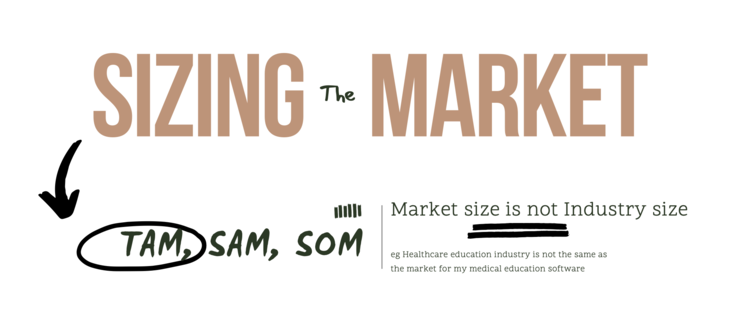Founder Series - Calculating TAM, SAM, SOM

By Ukeme Daniel
When it comes to calculating TAM (total addressable market), I've encountered numerous founders who are unsure of how to proceed or where to even find the necessary information. At this point, I have encountered more than a handful of founders who are ready to fight to the death on how to calculate TAM (total addressable market) or even where to get the info. My usual response is, “Sir, simply taking industry numbers and dumping it as the total addressable market is a no-go. It's not enough to simply take industry numbers and use them as your total addressable market.
To put it simply, TAM is a numerical representation of the largest possible market for your product. It answers the question of what the total demand for your product could be if every person who wanted it purchased it. TAM is a product of two factors: the number of customers and the revenue per customer.

There are two primary approaches to calculating TAM: top-down and bottom-up. The top-down approach is more general, but less accurate, while the bottom-up approach is more precise.
It's important to note that market and industry are two distinct concepts that are often conflated. Market refers to the specific segment of the industry that your product targets.
It's a misconception to think that you can't make realistic calculations for your business if you're in the early stages without a product or revenue. You should base your estimates on some level of data, whether from secondary or primary research. For companies like this, it's better to use a top-down approach to calculate your total addressable market (TAM).
Here's how the top-down approach works:
- Find information on the market you want to operate in. How much money is spent on this market?
- For example, let's say the total spending on at-home test kits in the US is $2 billion (fictional). But your startup is focused on creating test kits for screening genitourinary conditions. Your research shows that at-home test kits for women account for 60% of the market, and only 20% of that is spent on kits for GU conditions in women.
- Calculate the spending for each segment. For at-home test kits for women, the spending would be $2 billion x 0.60 = $1.2 billion. For at-home test kits for GU conditions in women, the spending would be $1.2 billion x 0.20 = $250 million.
- Therefore, your estimated TAM based on the top-down approach would be $250 million.
Using this approach, you can estimate your market size even if you're in the early stages of your business without any revenue or products.
Let's explore a bottom-up approach to estimating your total addressable market (TAM) using a hypothetical scenario. Suppose you're developing a screening kit called Capture-X that detects and measures viral load in urine. With initial funds from friends and family, you built a prototype and found that primary care settings, including primary care physicians, independent physician assistants, and nursing practitioners with independent clinics, may be the most useful market. You plan to start by targeting physicians in urban areas in the United States.
To estimate your TAM, you need to know how many target customers there are and how much revenue you can generate from each one.

Here's how you can calculate it:
- Using a database, you estimate there are 7,000 doctors in the US that fit your criteria.
- You've determined that the best unit price for your product is $50 per kit, and each doctor will need 1,000 kits per year based on historical data.
- The annual revenue from each doctor is 1,000 x $50 = $50,000.
- The TAM is the product of the number of customers and the revenue per customer. Therefore, 7,000 doctors x $50,000 = $350 million is your estimated TAM.
Both top-down and bottom-up approaches can be useful in estimating your TAM, and if you do it right, the numbers should be close. To calculate your TAM accurately, you need to know your beachhead market, target market, and how many customers are in it. You also need to determine the current or initial price of your product and annualize it as needed.

So what is the best approach? Doing Both. If you do it right, the numbers should be close.
Pro-section

SAM x SOM
It's essential to understand that the Serviceable Addressable Market (SAM) is a subset of the Total Addressable Market (TAM), and the Serviceable Obtainable Market (SOM) is a subset of SAM. Here's a quick illustration to explain these concepts:
SAM:
Suppose you only have one hub at your local accelerator and can't serve the entire US due to high shipping costs. You decide to focus on Texas, where 1,000 of the 7,000 doctors fit your target market criteria. Therefore, your SAM is 1,000 doctors x (1,000 kits x $50) = $50,000,000 ($50M).
SOM:
Based on your current manufacturing equipment set-up, you can only produce 50,000 kits per year, which covers only 0.05% of the 1 million device market need in Texas. Therefore, your SOM is 50,000 x $50 = $2.5M.
To summarize, it's important to distinguish between a market and an industry, and both top-down and bottom-up approaches can be useful at different stages of a company. The bottom-up approach tends to be more accurate, but doing both approaches can yield a better estimation of TAM. Remember that TAM is a product of the number of customers and the revenue per customer, not the price per product.
No one expects your deck to be perfect, but there should be a logical approach to how you got your numbers.
You can’t simply copy and paste numbers you found on an industry report.
If you need further help join our community.





